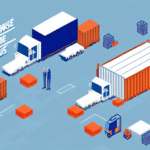Importance of Choosing the Right Fulfillment Center Location
Selecting the right order fulfillment center location is a pivotal decision when outsourcing third-party logistics (3PL) services for your business. The geographic location of your fulfillment center can significantly influence your shipping and delivery timeframes, shipping costs, and overall customer satisfaction. According to a study by Inbound Logistics, optimizing fulfillment center locations can reduce shipping costs by up to 15% and improve delivery speeds by 20%.
The Role of 3PL Providers in Order Fulfillment
Third-party logistics (3PL) providers offer a range of logistics and supply chain services, including order fulfillment, warehousing, and transportation management. By partnering with a reputable 3PL provider, businesses can leverage their expertise, technology, and network of fulfillment centers to streamline operations, scale efficiently, and reduce costs. According to a Statista report, the global 3PL market is projected to reach $1.3 trillion by 2026, underscoring its critical role in modern supply chains.
Key Factors to Consider When Selecting a 3PL Fulfillment Center
Analyzing Customer Base and Sales Data
Understanding where your customers are located is essential for determining the optimal location of your fulfillment center. By analyzing sales data and customer demographics, businesses can identify regions with high order volumes and strategically position fulfillment centers to minimize shipping distances. Tools like Google Analytics and customer relationship management (CRM) systems can provide valuable insights into customer distribution and purchasing patterns.
Geographic Location: Shipping Costs and Delivery Timeframes
The geographic location of a fulfillment center directly impacts shipping costs and delivery times. Centers located closer to major customer bases can offer faster delivery, enhancing customer satisfaction. Additionally, proximity to diverse shipping options can provide cost-effective solutions. According to the Geodis State of Logistics Trends Report, companies can reduce shipping costs and delivery times by strategically locating fulfillment centers within key regions.
Proximity to Major Transportation Hubs and Routes
Being near major transportation hubs like airports, seaports, and interstate highways is crucial for efficient logistics operations. Proximity to these infrastructures facilitates faster and more reliable transportation of goods, reduces transit times, and minimizes the risk of delays. For instance, fulfillment centers located near the Port of Los Angeles benefit from direct access to international shipping routes.
Facility Requirements: Climate Control, Security, and Infrastructure
Ensuring that the fulfillment center has the necessary infrastructure to handle your specific product requirements is vital. Climate-controlled facilities are essential for perishable or temperature-sensitive items, while robust security measures protect inventory from theft and damage. Additionally, modern infrastructure with advanced technology and automation can enhance operational efficiency. The Warehouse & Logistics News highlights the growing importance of automation in fulfillment centers for improving accuracy and speed.
Balancing Cost Savings with Service Quality
While cost savings are important, they should not come at the expense of service quality. It's essential to balance affordability with the ability to provide reliable and efficient fulfillment services. Choosing a 3PL provider that offers competitive pricing without compromising on service standards ensures long-term business sustainability. Evaluating factors such as order accuracy rates, return handling capabilities, and customer support can help in making an informed decision.
Best Practices for Partnering with 3PL Providers
Negotiating Contracts
When negotiating contracts with 3PL providers, it's important to clearly define terms and conditions that align with your business objectives. This includes establishing service level agreements (SLAs), performance metrics, and pricing structures. Transparency in contract negotiations can prevent misunderstandings and ensure that both parties are committed to achieving desired outcomes. Referencing best practices from the Supply Chain Digital can aid in drafting comprehensive agreements.
Managing Operations Across Multiple Fulfillment Centers
For businesses operating across various regions, managing multiple fulfillment centers can be complex. Implementing standardized processes and utilizing robust warehouse management systems (WMS) can ensure consistency and efficiency across all centers. Integration with inventory and order management systems enables real-time visibility and coordination. The Inbound Logistics offers strategies for effective multi-center management.
Tracking KPIs and Metrics
Monitoring key performance indicators (KPIs) is essential for evaluating the effectiveness of your fulfillment operations. Important KPIs include order accuracy, fulfillment cycle time, shipping cost per order, and customer satisfaction scores. Regularly tracking these metrics facilitates continuous improvement and helps identify areas needing attention. Utilizing analytics tools and dashboards can provide actionable insights for optimizing fulfillment processes.
Conclusion
Choosing the right order fulfillment center location is a strategic decision that can significantly influence your business's logistics efficiency, cost management, and customer satisfaction. By carefully evaluating key factors such as geographic location, proximity to transportation hubs, facility standards, and partnering effectively with 3PL providers, businesses can optimize their supply chain operations. Leveraging data-driven insights and adhering to best practices ensures that your fulfillment strategy supports sustainable growth and competitive advantage in the market.






















